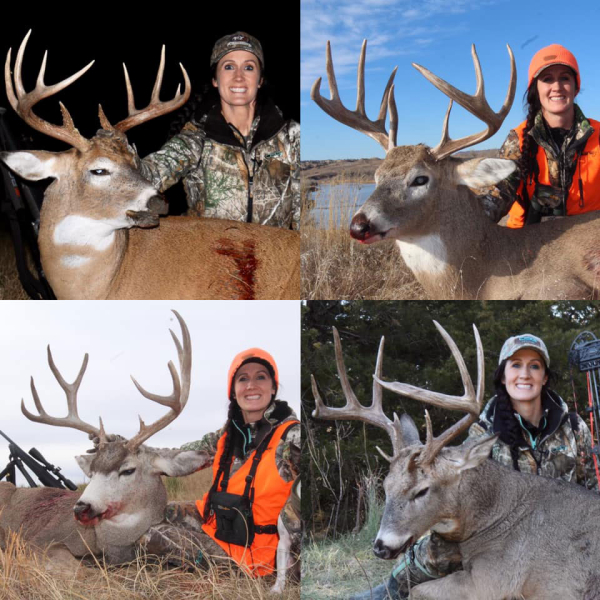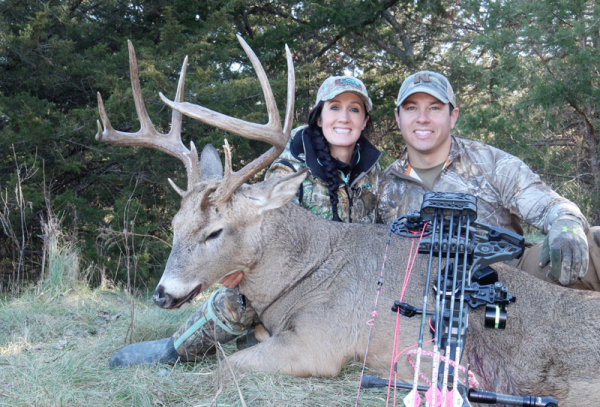Some hunters walk away after a season shaking their head and wondering where it went wrong – and then immediately think about how they can improve upon next year’s hunts. Other hunters rejoice in a season where everything (mostly) worked to their favor. You might be wondering who the heck are the hunters in the latter bucket… the ones where a successful season was hard fought – and won; a season where it seemed all the efforts put in the previous years (decades) finally came together.
Well, one such hunter in that bucket is Melissa Bachman, host of Winchester Deadly Passion airing her ninth season on Sportsman Channel Sundays at 11:30 a.m. ET. Bachman’s 2019 deer hunting season is epic, as you would know if you follow her on Instagram (@melissa_bachman) or on Facebook @WinchesterDeadlyPassion. For example, in November, in a matter of seven days, she harvested four bucks. FOUR. BUCKS. IN. ONE. WEEK.

Now, my dear readers, we all know this doesn’t happen by the stroke of luck or by having something “handed to you,” as many of you might be thinking. No, this happened because Bachman has been hunting literally her entire life- practically 300 days OR MORE per year. So perhaps it is a matter of numbers. Remember Malcom Gladwell’s “10,000 hours” he introduced in the book Outliers in 2008? In it, Gladwell said that “Ten thousand hours is the magic number of greatness.” In summary, anyone performing at THE highest level – be it a violinist playing at Carnegie Hall – or a hunter honing their skills – it takes 10,000 hours of practice, hard work and dedication to that skill. These people are outliers. There aren’t many of them, and that’s what makes them so great. Has Bachman put in 10,000 hours over the course of her young lifetime into hunting? Would she be considered an outlier? I say “yes.” - Michelle Scheuermann, editor, Archery Wire
Q1: Melissa, what are some of the key pieces you did to prepare for your 2019 hunts? Please share the amount of time each piece of the puzzle takes.
A1: Some of the main things we do as far as scouting revolves around planting food plots, scouting and glassing from high points, putting out SpyPoint trail cameras and creating our little buck paradise setups in front of our blinds. These areas includes a water tank, cedar rub post, licking branch, mock scrape with a Magnum Scrape Dripper all followed up by a camera and blind. All these elements take a lot of time to create and install (such as digging umpteen water holes in July), but we really look at hunting as a year-round activity as there is always something that can be done to increase your odds once the season finally hits.

Q2: You truly put in a lot of work – adding blinds, waterholes, licking branches and more to your location. Why do you add all these things to each location?
A2: Where we hunt the deer, they don’t always live right there. We often hunt bucks that pass through so you need a reason for them to come to your specific location. By creating this entire setup right in front of your blind, you’re setting yourself up for the perfect close shot and making it a destination for the deer, not just a pass-through point.

Q3: It may seem like you shot four deer just in one week, but that’s not the entire story. You sat in those blinds and stands for HOURS prior to getting any of those bucks. Can you share your strategies for sitting in a blind? The time you put in?
A3: Yea I did have one incredibly lucky week, but I guess you could say the entire month of October was a lot less lucky. I hunted a ton sitting dark to dark for a good part of October and most of November before running into this “lucky streak.” Again, you never know when the time will be right, so I always try to sit as long as possible. If there isn’t something absolutely necessary for me to leave the stand for, I’m in all day. The reason for this is it’s a lot less pressure on your area. Its two less trips in and out each day plus I’ve shot numerous big bucks around the noon hour. The trick is trying to make yourself as comfortable as possible on stand or in a blind, bring a lot of snacks and food, and be mentally prepared for very long and possibly boring sits. We had SpyPoint pics coming in at a wide variety of times so I knew it could happen at any moment.

Q4: Share with us which of the four bucks is your most favorite story, the one you were most thrilled about finally getting.
A4: Out of all those bucks the most exciting one was probably my archery deer. This was a buck we had Spypoint photos of all season and one I really wanted a chance at. Unfortunately earlier in the season I had him come in but he was quartering to and didn’t offer a shot. He backed out, not liking something in the setup and I figured that was our one chance. This gave me more incentive to keep hunting hoping as the rut heated up he’d make a mistake and eventually want to come fight my decoy or stop by the mock scrape. I lost track at the number of all-day sits I did after this point but I was starting to lose confidence. Then we started getting regular photos of the buck; my husband saw him about 150-yards from my setup on numerous occasions while I was hunting and I hoped it was just a waiting game. Finally on the last day my camera man could stay, this buck strolled through on the furthest trail possible and I made the shot at 56-yards. The feeling of accomplishment walking up on this buck was unreal. So much time and effort had gone into this and I was literally wore down. We had been going non-stop driving through the nights going from location to location as the rut was on. To end the week and tag my fourth buck in seven days, this made all the effort year-round well worth it!